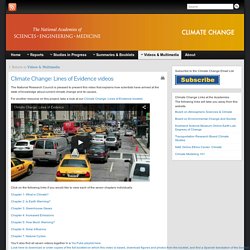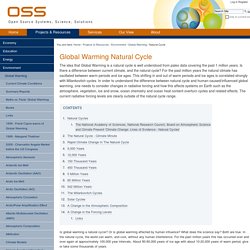

ESRL Global Monitoring Division - Global Greenhouse Gas Reference Network. Calendar | People | Publications Earth System Research Laboratory Global Monitoring Division Global Greenhouse Gas Reference Network Trends in Atmospheric Carbon Dioxide History of atmospheric carbon dioxide from 800,000 years ago until January, 2014.

Download full-resolution version of this animation (warning: large file, ~53 MB) U.S. Privacy Policy | Accessibility | Disclaimer | USA.gov Contact Us | Webmaster Site Map. Climate Change: Lines of Evidence videos » Climate Change at the National Academies of Sciences, Engineering, and Medicine. ↑ Return to Videos & Multimedia Print this Page Climate Change: Lines of Evidence videos The National Research Council is pleased to present this video that explains how scientists have arrived at the state of knowledge about current climate change and its causes.

For another resource on this project, take a look at our Climate Change: Lines of Evidence booklet. Click on the following links if you would like to view each of the seven chapters individually. What's Really Warming the World? Climate deniers blame natural factors; NASA data proves otherwise.
Climate scientists tend not to report climate results in whole temperatures. Instead, they talk about how the annual temperature departs from an average, or baseline. They call these departures "anomalies. " They do this because temperature anomalies are more consistent in an area than absolute temperatures are. For example, the absolute temperature atop the Empire State Building may be different by several degrees than the absolute temperature at New York’s LaGuardia Airport. But the differences from their own averages are likely to be about the same. Credibility Spectrum. Let’s face it, there’s a lot of “climate science” out there that’s absolute rubbish.

Type “climate change” into Google. Within seconds you can find statements that the Earth is warming or that its temperatue is stable (or cooling since 1998!). You can find “proof” that the warming is caused by the sun, volcanoes, flaws in the temperature data, or fossil fuel burning. You can read that the Hockey Stick graph is broadly accurate, or that it was manipulated by the IPCC to agree with a predetermined conclusion. Whatever you read about climate change, chances are that there’s another source saying the opposite thing. When people ask me this question, I invariably respond with, “Assess the credibility.” The ”climate change analysis” you read could be from a national academy of science, or from a blogger.
I’ve put together a climate change credibility spectrum, inspired by Greg Craven from the Manpollo Project. Like this: Like Loading... Global Warming Natural Cycle — OSS Foundation. Is global warming a natural cycle?

Or is global warming affected by human influence? What does the science say? Both are true. In the natural cycle, the world can warm, and cool, without any human interference. For the past million years this has occurred over and over again at approximately 100,000 year intervals. Arguments from Global Warming Skeptics and what the science really says. The consensus project. EPA: Causes of Climate Change. 10 Indicators of a Human Fingerprint on Climate Change. Posted on 30 July 2010 by John Cook The NOAA State of the Climate 2009 report is an excellent summary of the many lines of evidence that global warming is happening. Acknowledging the fact that the planet is warming leads to the all important question - what's causing global warming?
To answer this, here is a summary of the empirical evidence that answer this question. Many different observations find a distinct human fingerprint on climate change: To get a closer look, click on the pic above to get a high-rez 1024x768 version (you're all welcome to use this graphic in your Powerpoint presentations). Humans are currently emitting around 30 billion tonnes of CO2 into the atmosphere every year (CDIAC). Science isn't a house of cards, ready to topple if you remove one line of evidence. How do we know that recent CO2 increases are due to human activities? Note:This is an update to an earlier post, which many found to be too technical.

The original, and a series of comments on it, can be found here. See also a more recent post here for an even less technical discussion. Over the last 150 years, carbon dioxide (CO2) concentrations have risen from 280 to nearly 380 parts per million (ppm). The fact that this is due virtually entirely to human activities is so well established that one rarely sees it questioned.
Yet it is quite reasonable to ask how we know this. One way that we know that human activities are responsible for the increased CO2 is simply by looking at historical records of human activities. Another, quite independent way that we know that fossil fuel burning and land clearing specifically are responsible for the increase in CO2 in the last 150 years is through the measurement of carbon isotopes. CO2 produced from burning fossil fuels or burning forests has quite a different isotopic composition from CO2 in the atmosphere. To What Degree? - What Science Is Telling Us About Climate Change - How Do We Know?